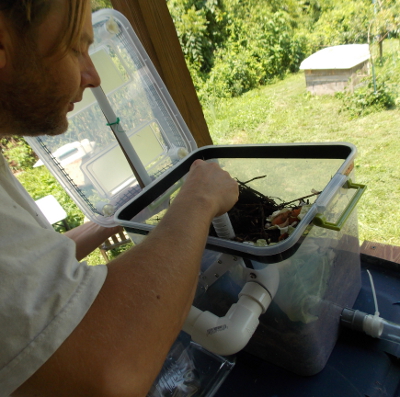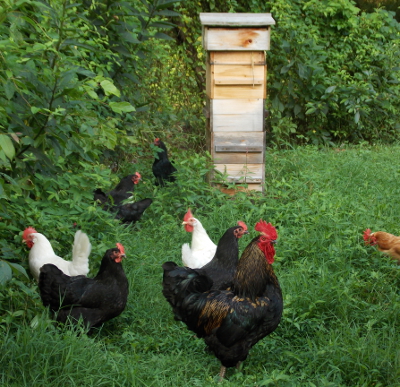
How many chickens will a black soldier fly bin feed?
 "How much chicken feed will [your black soldier fly bin] produce? How many grubs are
you expecting per week? Will it be enough to be a
substantial caloric addition or is this just for a treat? Will this
replace any supplements you may currently use?"
"How much chicken feed will [your black soldier fly bin] produce? How many grubs are
you expecting per week? Will it be enough to be a
substantial caloric addition or is this just for a treat? Will this
replace any supplements you may currently use?"
This is a good question,
but the answer is a bit complicated. As a starting point, the
number of grubs you get from a unit like ours will depend on how much
food you provide and on how well colonized your unit is. Best-case
scenario is that our six-gallon unit can handle 2 pounds of food scraps
per day, which will be converted into 0.2 to 0.4 pounds of black
soldier fly larvae per day. Of course, if you don't do everything
perfectly, you'll get less.
Mass Production of Beneficial Organisms: Invertebrates and Entomopathogens
suggests that black soldier fly larvae (fresh, I think, but the table
is a bit unclear) provide 1,994 calories per kilogram. That would
mean that our daily 0.2 to 0.4 pounds of black soldier fly larvae would
provide 180 to 360 calories, equivalent to the daily energy needs of half to one chicken.
 But
that doesn't mean our bin will only feed half a chicken. Protein
makes up about 35% of the calories in black soldier fly larvae, meaning
that you should consider the grubs to be more like soybeans than like
the 16%-protein feed mixtures from the store. Since soybeans often
make up about a third of the weight of store-bought
chicken feed, it's conceivable that our bin's daily output could equate
to supplemental protein for 1.5 to 3 chickens.
But
that doesn't mean our bin will only feed half a chicken. Protein
makes up about 35% of the calories in black soldier fly larvae, meaning
that you should consider the grubs to be more like soybeans than like
the 16%-protein feed mixtures from the store. Since soybeans often
make up about a third of the weight of store-bought
chicken feed, it's conceivable that our bin's daily output could equate
to supplemental protein for 1.5 to 3 chickens.
But how do you work around having this supplemental protein source on hand? You might get away with mixing one of these homemade layer feeds
and simply substituting black soldier fly larvae for soybeans (figuring
that a pound of dry roasted soybeans is equivalent to about 2.24 pounds
of fresh black soldier fly larvae). Or, on a smaller scale, you
could simply provide your chickens with all the black soldier fly larvae
you have available and then also provide an automatic feeder full of
store-bought feed and another of grain so the chickens can lower the
overall protein level of their diet (by eating more grain) as they see
fit.
No matter how you figure
it, having a high-protein, animal-based feed available for chickens
should cut feed costs and improve the birds' health, along with boosting
the nutritional density of the eggs and meat the chickens
provide. The real question will be --- is the positive impact
greater than if we simply fed our food scraps to the chickens (as we
currently do) instead of to the black soldier fly larvae?
Want more in-depth information? Browse through our books.
Or explore more posts by date or by subject.
About us: Anna Hess and Mark Hamilton spent over a decade living self-sufficiently in the mountains of Virginia before moving north to start over from scratch in the foothills of Ohio. They've experimented with permaculture, no-till gardening, trailersteading, home-based microbusinesses and much more, writing about their adventures in both blogs and books.
Want to be notified when new comments are posted on this page? Click on the RSS button after you add a comment to subscribe to the comment feed, or simply check the box beside "email replies to me" while writing your comment.

Dear Anna, I was the happy recipient of a box of walking onions from your sweet father last year. I planted the small bulbs and was pleasantly surprised at how prolific they grew! Unfortunately, my family is having a hard time liking the taste the consistency of the bulbs. The greens are great and I've added them to many dishes and have begun freezing/ drying for use through the winter. But the bulbs are tough and bitter. Even after cooking the bulbs are chewy and fibrous. What did I do wrong? Did I leave them in the ground too long?